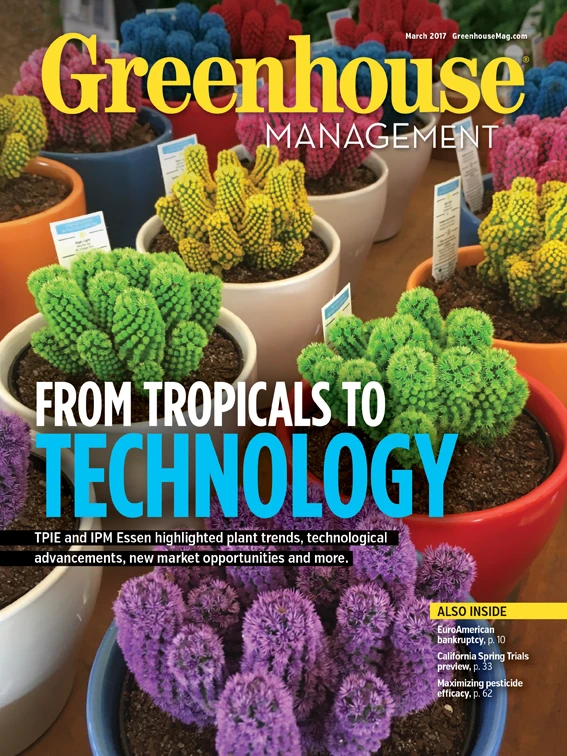
Greenhouse Management: Can you explain what the term “viral disease” means in a growing context?
Dr. Janna Beckerman: In a human context, we think of it as something that would be spread through casual contact, like sneezing. But with plants, there’s very specific context as to how different viruses are spread. [For] some viruses, [this spread] can almost be [through] casual contact, like tobacco mosaic virus, TMV. You touch a plant, you touch another plant, and if the first plant was infected, you could spread tobacco mosaic virus that way.
But for other viruses, it’s very difficult to spread the disease. That would be like a Hosta virus X, for example, where we're not exactly sure, or rose mosaic virus, where we're not exactly sure how the disease spreads.
GM: What are some of the common diseases that can be viral diseases in the greenhouse?
JB: The classic is tobacco mosaic virus, and anybody who smokes cigarettes could potentially transmit tobacco mosaic virus to their plants just through the casual act of touching a cigarette and then touching the plant — it’s that contagious.

Other common ones would be tomato spotted wilt virus, and impatiens necrotic spot virus would be another. Both are tospoviruses, which are transmitted by thrips.
GM: How do you treat viral disease in the greenhouse, and is it significantly different from how you would normally treat disease?
JB: The treatment is different and a lot of it depends on which virus that you have. And unfortunately, you can’t cure a plant, for the most part. I'm going to say that loosely, because of course, there are always exceptions. But if you find virus-infected plants in your greenhouse, the best thing to do would be to dispose of them. That way, if it is a virus that is vectored by a common insect — be it like a whitefly or thrips or something, or aphids — you don’t have to risk that spread of the virus throughout the greenhouse. There’s very little tolerance, and the only way to really manage it is to control the vector and remove the source of disease.
GM: Are there ways that you can work gradually and thoughtfully to prevent viral disease being something that could affect your greenhouse?
JB: One of the best ways is [by] incorporating disease-resistant varieties, and in the case of a lot of vegetables, there are vegetables that are resistant to certain viruses. Another way is making sure that workers, particularly workers that smoke, are always gloved and aren’t handling material and that their hands are clean in between use. There are a variety of different things they can do to make sure they don’t spread tobacco mosaic virus. But the best thing is to make sure that their hands aren’t in contact with cigarettes and then plants.

GM: For those that might not know exactly how to identify it, what are some signs that your plants might be infected with tobacco mosaic virus?
JB: Some of the symptoms of tobacco mosaic would be color break in either the leaves or in the flower. There’s also distortion. With tomato spotted wilt and impatiens necrotic spot, you do get these small little black spots. It sometimes even looks very fungal.
In some instances, you get some nice target-shaped radiating chlorotic lesions, so it literally looks like a bull’s eye on certain infected plants with tomato spotted wilt virus and impatiens necrotic spot virus. Other times, it could just be a general mosaic or a mottle, even where it’s just alternating yellow and green patterns. And some plants could be completely asymptomatic, too. And others are just stunted — they're smaller than normal and just maybe don’t look quite right.
GM: Are there any specific plants that are perhaps more susceptible to viral disease?
JB: Growers should assume that all plants are susceptible. If you start plants from seed, it’s much, much less likely to transmit a virus, but if something is clonally propagated and passed from hand to hand to hand, the likelihood of that increases. One way to avoid [disease spreading] would be starting everything from seed, which, obviously, would be a little hard to get clones — identical plants — that way.

Explore the March 2017 Issue
Check out more from this issue and find your next story to read.
Latest from Greenhouse Management
- Grant awarded to test western U.S. wood species for use as wood fiber potting substrate
- Pennsylvania Horticultural Society announces 2025 Gold Medal Plant winners
- Oasis Grower Solutions announces new Southeast territory sales manager
- A nation of gardeners: A history of the British horticulture industry
- Last Word with Angela Labrum, Bailey Nurseries
- Iowa plant supplier Plantpeddler building retail complex
- This month's Greenhouse Management magazine is about native plants and sustainability
- The HC Companies, Classic Home & Garden merge as Growscape






